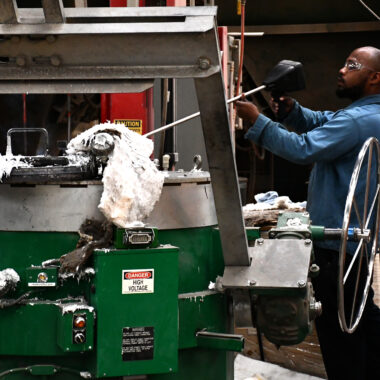Study the World of Light Weight Aluminum Spreading: Understanding the Different Methods
Light weight aluminum spreading is an essential procedure in the production sector, with numerous techniques used to develop accurate and elaborate elements. Comprehending the different methods used in light weight aluminum casting can offer important insights right into the capabilities and limitations of each technique. From the traditional sand casting approach to the advanced die casting process, each method uses distinct advantages relying on the needs of the task. Exploring these varied techniques can use a comprehensive view of the possibilities within the globe of aluminum spreading and just how each strategy contributes to shaping the modern-day production landscape.
Sand Spreading Method
Sand casting, a widely-used approach in light weight aluminum spreading procedures, entails developing molds constructed from compacted sand for putting liquified steel. This method is cost-effective and extremely versatile, making it a preferred option for numerous sectors. The procedure begins with the development of a pattern, typically made from wood or steel, which is after that pressed into the sand to leave a perception. The sand mixture, typically silica sand combined with a binder like clay, is firmly loaded around the pattern to develop a mold cavity. As soon as the mold and mildew prepares, it is firmly put in a flask and molten light weight aluminum is poured right into the dental caries.
After the metal has cooled and strengthened, the sand mold and mildew is broken away to disclose the light weight aluminum casting. Sand casting enables the manufacturing of complicated forms and huge components that may be pricey or hard to create utilizing other techniques. It is additionally a sustainable strategy as the sand can be recycled and utilized multiple times, decreasing waste in the casting process.
Long-term Mold And Mildew Method

One significant benefit of the Permanent Mold Technique is the enhanced dimensional precision it uses. The metal mold permits tighter tolerances and better information in the final aluminum castings compared to sand casting techniques. This accuracy makes it a favored choice for applications where limited dimensional control is essential, such as in the aerospace and vehicle industries.

Pass Away Casting Refine

Investment Casting Method
Using a precision spreading technique, Investment Casting Technique involves creating intricate light weight aluminum elements by pouring molten steel into a ceramic mold. This process, also referred to as lost-wax spreading, starts with the production of a wax pattern of the preferred component. This wax pattern is after that covered with a ceramic material to form a covering. When the ceramic shell is hardened, it is heated up to eliminate the wax, leaving behind a hollow ceramic mold.
Investment casting is generally made use of for manufacturing elements in industries where intricate layouts and limited tolerances are required, such as aerospace, automotive, and medical equipment. The versatility and accuracy of the Investment Casting Technique make it an important method in the world of aluminum casting.
Lost Foam Casting Approach
Having checked out the elaborate accuracy of Financial investment Casting Method, the emphasis now moves to the innovative method of Lost Foam Spreading in light weight aluminum component manufacturing. Lost Foam Spreading, additionally understood as evaporative go to these guys pattern spreading, is a modern method where a foam pattern of the wanted component is created and after that covered with a refractory product.
Additionally, Lost Foam Spreading is an economical procedure as it decreases the requirement for cores and enables for the production of light-weight elements. Despite its advantages, Lost Foam Casting needs cautious control of the spreading process to avoid flaws and ensure quality elements.
Conclusion
In conclusion, aluminum spreading offers a selection of methods such as sand spreading, irreversible mold technique, pass away spreading, investment casting, and shed foam casting. Each approach has its own benefits and applications, making light weight aluminum casting a versatile and commonly utilized procedure in various industries. Comprehending the distinctions in between these methods is important in picking one of the most suitable casting technique for certain manufacturing needs.
Sand spreading, a widely-used method in aluminum casting processes, involves producing molds made of compressed sand for putting liquified steel. aluminum casting.The Irreversible Mold And Mildew Strategy, like sand spreading, is an additional widespread approach used in light weight aluminum spreading procedures, supplying distinctive benefits in terms of mold and mildew reusability and dimensional precision. The steel mold and mildew enables for tighter tolerances and finer details in the final aluminum spreadings compared to sand casting methods. The two main types of die spreading are cool chamber pass away spreading and hot chamber die casting, each ideal for various types of aluminum alloys.In final thought, aluminum casting offers a variety of approaches such as sand spreading, long-term mold technique, die spreading, financial investment casting, and shed foam spreading
Comments on “The Ultimate Guide to Aluminum Casting: Professional Insights and Ideal Practices”